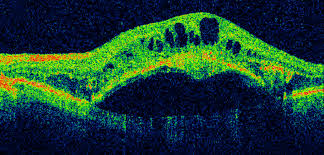
Role of Advanced Retinal Imaging in Management of Neovascular AMD
Dr Daniel Chiu
Prof Ursula Schmidt-Erfurth from Vienna, Austria discussed the use of powerful automated OCT machines with specialised computer algorithms that will allow clinicians to make treatment decisions more objectively to lighten the treatment burden for AMD patients without sacrificing the visual improvement gained by anti-VEGF therapy.
In her talk, she discussed the application of machine-learning using specialised computer algorithms to analyse a very large SD-OCT dataset collected during clinical trials in the treatment of neovascular AMD.
Tens of thousands of SD-OCT scans with characteristics such as intra-retinal fluid/cyst, subretinal fluid, pigment epithelial detachment and intra-retinal hyperreflective foci were carefully defined. They were then mapped by computer algorithmic categorisation and volumetric analysis.
With such an enormous dataset, many powerful findings were produced. Some were intuitive, some were surprising.
- Central retinal subfield thickness (CST) on its own fails to address the significance of different retinal compartment characteristics. CST as a predictor for visual function is non-linear and using CST as a marker for anti-VEGF re-treatment protocol in many PRN-based treatment strategies had produced inferior long-term results.
- Presence of subretinal fluid (SRF) in treatment of naive patients as well as its persistence during the course of anti-VEGF treatment is intriguingly associated with more benign disease course. It has a positive correlation with better visual function. Machine-based quantification of SRF and visual function outcome data has confirmed many clinical observations by astute physicians as well as various post-hoc studies on anti-VEGF treatment regimes. Less aggressive treatment regimes can thus be safely employed in patients with persistence of subretinal fluid alone without the presence of other imaging biomarkers.
- Volumetrically, change in intraretinal fluid (IRF) space (cyst) provides the strongest linear prediction on long term visual function in anti-VEGF treated patient and their overall response. Careful mapping and recording of the changes in IRF volumes by computerised quantitative analysis holds most promise in helping to individualise patient treatments.
As more powerful automated OCT machines and intelligent algorithms become available, machine-guided treatment decisions will allow clinicians to make treatment decisions more objectively to lighten the treatment burden of AMD.
The results from these “Large Data” computational analysis will no doubt influence the future design of many pharmacological interventional treatment trials with better, safer and more effective treatment protocols.
